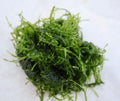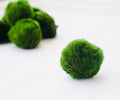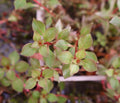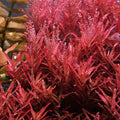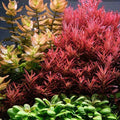3 Types of Aquarium Plants Fertilizers
Aquarium plants require nutrients to grow beautiful, and understanding these essential nutrients is the key to maintaining lush and vibrant aquatic world. Let's get started!
Macronutrients: N-P-K
First, let's focus on the primary nutrients that plants require, known as macronutrients:
Nitrogen plays an important role in chlorophyll production and its overall plant growth. If your plant's new leaves appear much lighter in green compared to the older ones, it could be a sign of a nitrogen deficiency.
Phosphorus is essential for energy transfer, phosphorus is critical for healthy plant development. Inadequate phosphorus can lead to the appearance of green spot algae on plant leaves.
Potassium is what most plants rely on for various cellular functions. A deficiency in potassium can result in small holes in plant leaves, sometimes encircled by a yellow ring.
It's worth noting that if you have fish, shrimp, or other tank inhabitants, their waste products already contain small amounts of these macronutrients. However, these levels are often insufficient for the demands of lush plant growth, primarily because potassium is required in more substantial quantities. Therefore, supplementing your aquarium with fertilizers becomes essential.
Micronutrients
In addition to macronutrients, plants also require micronutrients or trace elements. These include:
Iron: Crucial for photosynthesis and overall plant health.
Copper: Necessary for enzymatic processes in plants.
Zinc: Supports various growth-related functions.
Root Tabs
To maintain healthy growth, we recommend adding more root tabs about once every 6 to 8 weeks to continually build the nutrient base in the ground, especially if you are using an inert substrate like aquarium gravel or sand that doesn't contain any nutrients on its own. The release of nutrients, unlike liquid fertilizer, is not measurable. As mentioned, root tabs do not release nutrients into the water.
Recognizing Nutrient Deficiencies
If your plants lack certain nutrients, they will exhibit signs of nutrient deficiencies.
Here's how to spot them:
Nitrogen Deficiency: New plant growth appears pale compared to older leaves.
Phosphorus Deficiency: Plant leaves develop green spots, often indicative of green spot algae.
Potassium Deficiency: Small pinholes emerge in plant leaves, sometimes encircled by yellow rings.
These are just a few examples, and a wide array of nutrient deficiencies can be identified through online resources and guides. These symptoms serve as valuable indicators to help you address nutrient imbalances effectively.
Selecting the Right Fertilizer
For beginners, simplicity is key. You can find all-in-one complete liquid fertilizers that are perfect for those starting their aquascaping journey. These fertilizers typically contain nitrogen, phosphorus, potassium, iron, and trace elements in a single bottle, making plant nutrition hassle-free. Be sure to verify that the chosen fertilizer indeed includes all essential macro and micronutrients.
Substrate Fertilization
Substrates like this can absorb liquid fertilizers, benefiting your plants with both root and foliar nutrient intake. Aquafy Substrate is an excellent option for planted tanks, as it provides a nutrient-rich base for healthy root development. If this isn't your preference, you can opt for root tabs, which slowly release nutrients into the substrate.
Understanding planted tank fertilization is crucial for achieving the lush, vibrant aquatic ecosystem you desire. Whether you're a beginner or an experienced aquascaper, grasping the essentials of nutrient management ensures the health and beauty of your aquatic plants.



